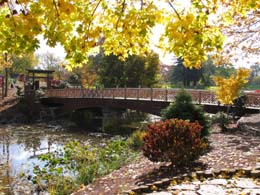On May 28, 2003, the City of Longview, in Cowlitz County, dedicates the Weyerhaeuser Centennial Bridge. Also called the Centennial Garden Pedestrian Bridge, the wooden structure connects a small island in Lake Sacajawea to the shore in downtown Longview. The bridge provides public access to a Japanese garden and symbolizes the sister-city relationship between Longview and Waco, Japan. In 2006, the 100-foot-long wooden pedestrian bridge will win first place in the National Timber Bridge Competition.
A Wooden Bridge
The bridge is made of wood, and is supported by arches set in concrete. Two glulam (glued, laminated timber) girders each 100 feet long provide the main span, which is supported by wooden arches about 70 feet long. The designer and contractor was Western Wood Structures, Inc. of Tualatin, Oregon.
There were engineering challenges in designing and constructing the bridge. It all had to be done from the mainland side as equipment could not be brought to the island. Also, Longview Parks Department designers did not want the arches to protrude above the deck. Thus the arches are shallow, single-member, two-hinged arches that produce substantial horizontal force at the arch abutments. A crane lowered the arches into their concrete foundation.
The total cost of the bridge was $172,000 of which the Weyerhaeuser Co. donated $98,000. The Longview Parks Department, Longview's sister city in Japan, and the City of Longview also contributed. The use of the crane and the concrete were donated by King Crane and by Evergreen State Concrete Plumbing.
Bringing Longview Closer to Japan
Longview had been working on the centennial park and Japanese garden since 1991, but few had gotten a close-up look at it before the bridge was in place. The garden has waterfalls, a stone lantern, a pagoda, and many plants.
On dedication day, Washington Governor Gary Locke (b. 1950) noted that the bridge represented Longview's friendship with Waco, and also the Northwest's relationship to Japan and to all of Asia. The ceremony was attended by officials from NORPAC, a Longview paper manufacturing concern co-owned by Weyerhaeuser and Nippon Paper Industries of Japan. Peter Ross, a Japanese flautist from Seattle, played in the garden as people crossed the new bridge to enter it and marvel at its beauty.
In February 2006 the bridge won a first-place award in the National Timber Bridge Competition for its "graceful flowing design" ("Longview Bridge Lands First-Place Award in Contest").

